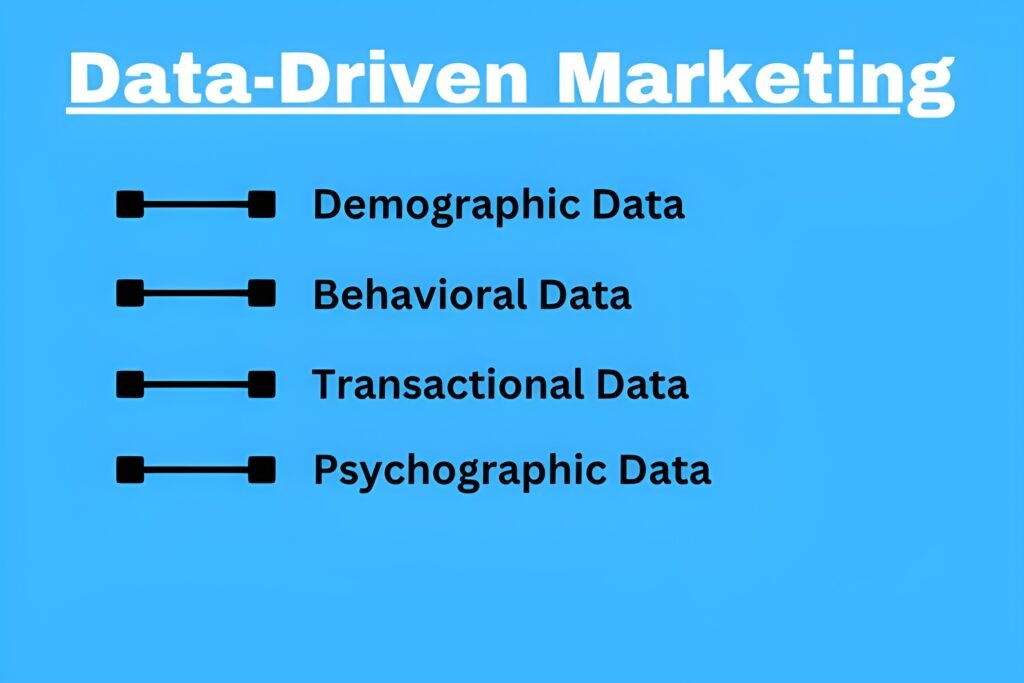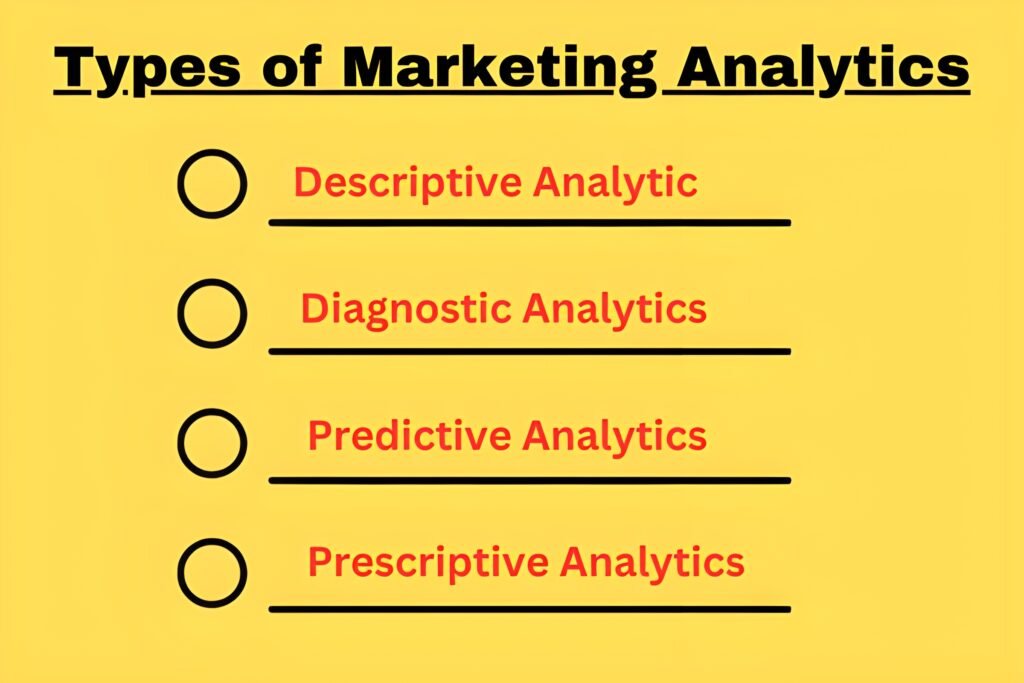Full Guide Of Data-Driven For Influencer Marketing, Marketing has evolved dramatically over the last two decades, moving from traditional advertising to a highly data-driven approach. With the rise of digital technologies, businesses now have access to vast amounts of customer data, allowing them to make informed decisions, personalize experiences, and optimize marketing efforts in real-time.
Data-driven marketing is not just a trend—it’s a necessity. Companies that harness data effectively can improve their customer targeting, increase conversion rates, and maximize return on investment (ROI). From small businesses to global enterprises, data analytics is transforming how marketing strategies are developed and executed.
- Why Data Analytics is Essential for Marketing?
- Difference Between Traditional Marketing Vs. Data-Driven Marketing
- Essential AnalyticsTools And Techniques
- Fundamentals of Data-Driven Marketing
- Types of Data-Driven Marketing
- How Can You Understand Marketing Analytics?
- Key Marketing Metrics and KPIs
- Role of AI and Machine Learning in Marketing Analytics
- Customer Data and Segmentation
- Creating Customer Personas
- Data Enrichment Techniques
- Data Sources and Collection Strategies
- How Can You Collect and Store Data?
- Tools and Technologies for Data-Driven Marketing
- Implementing Data-Driven Strategies
- Attribution Modeling and ROI Measurement
- Conclusion: The Future of Data-Driven Marketing
Why Data Analytics is Essential for Marketing?

Analytics provides insights that help marketers understand customer behavior, measure campaign performance, and predict future trends. Unlike Traditional marketing, which often relies on assumptions, data-driven marketing allows businesses to:
Analytics provides insights that help marketers understand customer behavior, measure campaign performance, and predict future trends. Unlike Traditional marketing, which often relies on assumptions, data-driven marketing allows businesses to:
- Identify their target audience with precision
- Personalize marketing campaigns
- Optimize budgets based on data insights
- Improve customer retention
- Enhance decision-making with predictive analytics
Without analytics, marketing efforts can be shot in the dark, leading to waste resources and missed opportunities.
Difference Between Traditional Marketing Vs. Data-Driven Marketing
| Aspect | Traditional Marketing | Data-Driven Marketing |
| Approach | Intuiton & Experience | Data Analytics |
| Targeting | Board Audience | Highly Segment Audience |
| Personalization | Generic Messaging | Personalised Dynamic Content |
| Design Making | Gut Feeling | Data Backed Strategies |
| Performance Measurement | Limited Tracking | Real Timr Analytics |
Essential AnalyticsTools And Techniques
To successfully implement data-driven marketing, businesses must leverage various analytics tools and techniques. Some of the most popular tools include:
- Google Analytics – Tracks website traffic, user behavior, and conversions.
- HubSpot – Provides insights into customer interactions and lead generation.
- Tableau & Power BI – Helps visualize complex data for better decision-making.
- Adobe Analytics – Advanced analytics for large-scale enterprises.
Techniques such as A/B testing, predictive analytics,and customer segmentation are crucial for refining marketing strategies and improving results.
Fundamentals of Data-Driven Marketing

Data-driven marketing is the practice of using data to optimize marketing strategies, target the right audience, and improve customer engagement. It Involves analyzing consumer behavior, preferences, and interactions to create highly relevant and effective campaigns.
Companies that use data-driven marketing can:
- Reduce marketing spend by focusing on high- performing channels.
- Deliver personalized experiences.
- Enhance customer satisfaction and loyalty.
- Benefits and Challenges of Data-Driven Marketing.
Benefits Of Data Driven Marketing
- Improved Targeting – Data helps marketers segment audiences based on demographics, interests, and behavior.
- Higher Conversion Rates – Personalized marketing campaigns increase engagement and sales.
- Cost Efficiency – Data allows businesses to allocate budgets effectively, avoiding unnecessary expenses.
- Better Customer Insights – Understanding customer preferences leads to better product recommendations.
- Enhanced Customer Experience –Personalized interactions improve customer satisfaction.
Challenges Of Data Driven Marketing
- Data Privacy Regulations – Compliance with GDPR, CCPA, and other privacy laws is essential.
- Data Overload – Handling vast amounts of data can be overwhelming without the right tools.
- Integration Issues – Combining data from multiple sources can be complex.
- High Initial Investment – Implementing Analytics Tools and training teams requires resources.
Types of Data-Driven Marketing

Effective Data-Driven marketing relies on different types of data, including:
- Demographic Data – Age, gender, income level, education Used for audience segmentation and targeting.
- Behavioral Data – Website visits, purchase history, email interactionsHelps in predicting customer preferences and future actions.
- Transactional Data – Purchase history, average order value, frequency of purchases Essential for customer lifetime value (CLV) analysis.
- Psychographic Data – Interests, values, lifestyle choices Helps create emotionally engaging campaigns.
How Can You Collect Data?
Marketers gather data from multiple sources, such as:
- Website analytics
- Social media interactions
- Customer surveys and feedback forms
- CRM systems
Third-party data providers, Each data source provides unique insights that help businesses refine their marketing strategies.
How Can You Understand Marketing Analytics?
Marketing analytics refers to the practice of measuring, managing, and analyzing marketing performance data to optimize campaigns and improve return on investment (ROI). It provides insights into customer behavior, campaign effectiveness, and overall business growth.
Marketing analytics enables businesses to:
- Understand customer preferences
- Identify successful marketing channels
- Optimize budget allocation
- Measure and improve campaign performance
Types of Marketing Analytics

Descriptive Analytic
Provides insights into past marketing performance
Answers “What happened?”
Example: Monthly website traffic reports, social media engagement metrics.
Diagnostic Analytics
Examines reasons behind trends or patterns
Answers “Why did it happen?”
Example: Analyzing why a particular campaign had a higher engagement rate.
Predictive Analytics
Uses historical data and machine learning to forecast future trends.
Answers “What is likely to happen?”
Example: Predicting which customers are most likely to convert.
Prescriptive Analytics
Recommends specific actions to improve performance
Answers “What should be done?”
Example: Suggesting the best time to send an email campaign based on past data.
Key Marketing Metrics and KPIs
Tracking the right metrics ensures businesses make data-based decisions. Some essential marketing KPIs include:
1. Website Analytics
- Traffic Sources – Where website visitors coming from.
- Bounce Rate – Percentage of users leaving the website without interaction.
- Conversion Rate – Percentage of visitors completing a desired action.
2. Email Marketing Metrics
- Open Rate – Percentage of recipients who open an email.
- Click-Through Rate (CTR) – Percentage Of recipients who click a link in the email.
- Unsubscribe Rate – Percentage of users opting out of emails.
3. Social Media Metrics
- Engagement Rate – Total interactions(likes, shares, comments) per post.
- Follower Growth – Increase in social media followers over time.
- Reach and Impressions – Number of users who see a post.
4. Paid Advertising Metrics
- Cost Per Click (CPC) – Amount spent per ad click.
- Return on Ad Spend (ROAS) – Revenue generated per dollar spent on ads.
- Ad Click-Through Rate (CTR) – Percentageofusers who clicked on an ad.
Role of AI and Machine Learning in Marketing Analytics

Artificial intelligence (AI) is transforming marketing analytics by automating data analysis, predicting customer behavior, and optimizing campaigns. Key Applications include:
- Chatbots – AI-driven customer service interactions.
- Recommendation Engines – Personalizedproductor content recommendations.
- Automated Reporting – AI-powered dashboards for real-time analytics.
- Sentiment Analysis – Understanding Customer Emotions from reviews and social media With AI-driven analytics, businesses can improve efficiency and make better data-driven decisions.
Customer Data and Segmentation
Customer segmentation is the process of dividing a business’s audience into smaller, more targeted groups based on specific characteristics. Thisallows businesses to create personalized marketing campaigns, improve customer engagement, and maximize ROI(Return Of Investment).
Effective segmentation helps:
- Increase conversion rates
- Deliver relevant content to customers.
- Optimize marketing spend
- Improve customer retention
Methods of Customer Segmentation
1. Demographic Segmentation
Based on age, gender, income, education, occupation, etc.
Example: A luxury brand targeting high-income individuals.
2. Geographic Segmentation
Based on location (country, city, climate, etc.)
Example: A clothing brand marketing winter jackets to colder regions.
3. Behavioral Segmentation
Based on customer behavior, such as purchase history, website activity, and brand loyalty.
Example: Offering discounts to customers who frequently abandon their shopping carts.
4. Psychographic Segmentation
Based on lifestyle, interests, values, and personality traits.
Example: A fitness company targeting health- conscious individuals.
Creating Customer Personas

A customer persona is a detailed profile of an ideal customer. It includes:
- Name and demographic details
- Buying habits and preferences
- Pain points and challenges
- Preferred communication channels
Example of a customer persona:
Name: Emily, 32 years old, digital marketing manager Uses social media daily for work and personal usePrefers high-quality, data-driven content Interested in tools that automate repetitive marketing tasks Creating personas helps businesses design to target campaigns that resonate with their audience.
Data Enrichment Techniques
Data enrichment involves enhancing existing customer data by adding more information. Methods include:
- Third-Party Data Integration – Supplementing Internal data with external sources.
- Survey Data – Collecting additional customer preferences through surveys.
- Behavior Tracking – Using cookies and analytics track customer actions.
By enriching customer data, businesses can refine their segmentation strategies and improve marketing effectiveness.
Data Sources and Collection Strategies

Understanding Data Sources in MarketingMarketing data comes from various sources, and understanding these sources helps businesses collect relevant insights. The three main types of data are:
- First-Party Data – Collected directly from customers (most valuable and reliable).
- Second-Party Data – Shared by another company(trusted but limited access).
- Third-Party Data – Purchased from external sources (useful but less accurate due to privacy concerns.
Sources of Marketing Data
1. Website and Mobile Analytics
Tools: Google Analytics, Hotjar, Adobe Analytics
Metrics: Traffic, user behavior, bounce rate, time on page
2. CRM Systems
Tools: HubSpot, Salesforce, Zoho CRM
Data: Customer interactions, purchase history, sales pipeline.
3. Social Media Analytics
Platforms: Facebook Insights, Twitter Analytics, LinkedIn Analytics
Data: Engagement, follower growth, impressions.
4. Email Marketing Platforms
Tools: Mailchimp, Constant Contact, SendGrid
Data: Open rates, click-through rates, conversion rates.
5. Surveys and Feedback Forms
Tools: Google Forms, Typeform, Survey Monkey
Data: Customer satisfaction, preferences, and sentiment analysis.
How Can You Collect and Store Data?
Use tracking pixels and cookies to monitor user behavior. Integrate analytics tools with marketing platforms for real-time insights. Ensure data security by encrypting sensitive customer information. Adopt a centralized Customer Data Platform (CDP) to unify data from different sources.
Privacy Concerns and Compliance
Marketers must comply with regulations such as:
- GDPR (General Data Protection Regulation) – Governs data privacy in Europe.
- CCPA (California Consumer Privacy Act) – Regulates data collection in California.
- HIPAA (Health Insurance Portability andAccountability Act) – Protects healthcare-related data.
Best practices for data privacy:
- Be transparent about data collection.
- Offer opt-in/opt-out options.
- Store data securely with encryption.
Tools and Technologies for Data-Driven Marketing

A variety of tools help businesses analyze marketing data. Below are the key categories and top tools in each:
Web and User Behavior Analytics
- Google Analytics – Tracks website traffic and user behavior.
- Hotjar – Provides heat maps and session recordings.
- Crazy Egg – Visualizes how users interact with a website.
Customer Relationship Management (CRM)Tools
- HubSpot – Automated marketing and sales processes.
- Salesforce – Comprehensive CRMfor large enterprises.
- Zoho CRM – Budget-friendly CRMsolution.
Social Media Analytics
- Hootsuite – Tracks social engagement across platforms.
- Sprout Social – Provides in-depth audience insights.
- Buffer – Measures post performance and audience interaction.
Business Intelligence and Visualization Tools
- Tableau – Data visualization for complex analytics.
- Power BI – Microsoft’s business intelligence tool.
- Looker – Cloud-based analytics for real-time insights.
Implementing Data-Driven Strategies

To successfully implement data-driven marketing, businesses must follow a structured approach. Here are the key steps:
Step 1: Define Clear Goals and KPIs
Start by identifying what you want to achieve. Common marketing goals include:
- Increasing website traffic
- Boosting conversion rates
- Enhancing customer engagement
- Improving ROI on ad spend
Each goal should be tied to measurable Key Performance Indicators (KPIs) such as:
- Website traffic (measured in sessions or users)
- Lead conversion rate (%)
- Customer acquisition cost (CAC)
- Customer lifetime value (CLV)
Step 2: Collect and Organize Data
Gather data from various sources, including:
- Web analytics (Google Analytics, AdobeAnalytics)
- CRM data (HubSpot, Salesforce)
- Social media insights (Facebook Insights, TwitterAnalytics)
- Customer surveys and feedback
- Use Customer Data Platforms (CDPs) to unify and organize data for better decision-making.
Step 3: Perform Data Analysis and Insights Extraction
Use business intelligence tools (Tableau, PowerBI, Google Data Studio) to visualize and analyze trends.Key analytical techniques include:
- Segmentation Analysis – Grouping customers based on behavior.
- Predictive Analytics – Using past data to forecast future trends.
- Cohort Analysis – Studying groups of users overtime to track retention.
Step 4: Optimize Campaigns Using A/B Testing
A/B testing involves comparing two variations of marketing elements to see which performs better. Common areas for testing include:
- Email subject lines
- Landing page designs
- Ad creatives and copy
Example: If Version A of an email has a 25%open rate and Version B has a 30% open rate, Version is the better choice.
Step 5: Personalize Marketing Efforts
Data-driven personalization increases engagement and conversions. Examples include:
- Email Personalization: Dynamic content based on user behavior.
- Product Recommendations: AI-driven suggestions(e.g., Amazon’s “Customers also bought” feature).
- Targeted Ads: Using retargeting techniques to reach users who showed interest in a product.
Step 6: Measure Performance and Adjust Strategy
Continuous measurement ensures ongoing optimization. Key metrics to track include:
- Conversion Rate: % of users who completed a desired action.
- Return on Investment (ROI): Revenuegeneratedper marketing dollar spent.
- Churn Rate: % of customers who stop engaging or purchasing.
Example: If email engagement drops, marketers can tweak subject lines, sending times, or segmentation for better results.
Attribution Modeling and ROI Measurement

Marketing attribution is the process of identifying which channels and touchpoints contribute conversions. This helps marketers allocate budget efficiently and optimize campaigns.
Types of Attribution Models
1. First-Touch Attribution
Gives full credit to the first touchpoint user interacted with.
Example: A customer first clicks on a Facebook Ad, then later buys through an email campaign. First- touch attribution credits the Facebook ad for the sale.
2. Last-Touch Attribution
Credits the final interaction before conversion.
Example: A user sees a Google ad, visits the website,and later clicks an email to purchase. The Mail gets full credit.
3. Multi-Touch Attribution
Distributes credit across multiple touch points in the customer journey.
Example: A user clicks a social ad (30%credit), reads a blog (20%), and completes a purchase via email (50%).
4. Data-Driven Attribution
Uses machine learning to assign weights to different touch points based on real data.
Example: Google Analytics’ Data-DrivenAttributionModel determines which touchpoints had the most impact on conversions.
Conclusion: The Future of Data-Driven Marketing
The Evolution of Marketing ThroughDataMarketing has transformed significantly over the years, shifting from intuition-based strategies to data-driven decision-making.
The rise of digital platforms, artificial intelligence(AI), and machine learning (ML) has given businesses unprecedented access to consumer insights.
Companies that leverage data effectively can optimize campaigns, personalized experiences, and maximize return on investment (ROI).
Data-driven marketing is no longer optional—it’s essential. Businesses that fail to embrace analytics risk falling behind competitors house data to enhance customer experiences and drive business growth.



Pingback: 20 ChatGPT Prompts Successful Digital Marketing Actually Use - content hobby
Pingback: The Ultimate Guide to Social Media Marketing 2025 -